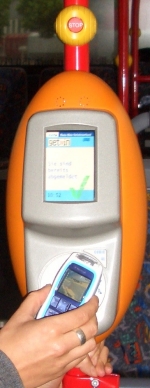In what is believed to be the first commercial deployment of Near Field Communication (NFC) technology, the Rhein-Main Verkehrsverbund (RMV), the public transport authority for the greater Frankfurt, Germany, area, has launched a system enabling its customers to use NFC-enabled mobile phones to pay for travel on nearly 200 busses operating in the city of Hanau, just outside Frankfurt.
NFC technology, which evolved from a combination of contactless identification (RFID) and interconnection technologies, operates at 13.56 MHz over a distance of typically a few centimeters. By enabling handsets to be used to access its services in place of contactless smart cards, RMV hopes to reduce costs from issuing smartcards and to extend its services to include wireless downloads of timetables or fare offers.
Deployment of the new NFC-enabled payment system, Handy, requires phones equipped with the RMV payment software application and follows a 10-month trial that ended last December. That trial consisted of 160 passengers selected by RMV and assigned NFC-enabled Nokia 3220 cell phones loaded with an application that would register their travel.
Under existing contactless smart-card payment system, which RMV launched in 2001, , Hanau bus passengers have their contactless smart cards read by RFID interrogators installed inside the vehicle. Upon entering or leaving the bus, the passenger brings the card within a few inches of the interrogator’s antenna, which reads the unique ID number store on the card’s RFID chip. The smart card contains a Philips Semiconductors‘ MiFare RFID chip, which adheres to the ISO 14443A standard, and operates at 13.56 MHz. Each month a bill is sent to the passenger listing the journeys made and the amount due.
The NFC is compatible with the ISO 14443A standard, and the phones operate in a similar way to the smart card by using the phone to emulate the same 13.56 MHz signal and data.
However, the because of the power needed to drive the software and hardware that emulates a contactless smart card in the NFC-handsets, the phones can not be used to pay for travel if they are switched off or the battery is exhausted.
According to RMV, at the end of the trial, more than 90 percent of the trial participants considered using a mobile phone for to pay for transit fare was a positive, convenient system worth continuing.
“The people in the trial were really excited about the new system, even after 10 months of using them,” says Holger Kunkat, program manager for mobile secure NFC solutions at Philips Semiconductors, which supplies the NFC chips and smart-card controllers used in the NFC phones. “People tend to forget their wallets, but they always have their phones with them.”
Launched today, the system is limited to only one mobile handset model from one telecom provider. Nokia’s 3220 NFC-enabled handsets are the only handsets available to work with the system, and Vodafone will be the only supplier of the phones. Nokia, Philips and Vodafone all worked with the RMV to develop the system.
Vodafone will be responsible for registering each phone’s owner with the RMV, as well as loading the two RMV software applications required on each handset. One is a payment application that manages the customer details and interacts with the bus readers, while a second enables the NFC-phones to be used as loyalty cards as a way to reward passengers for using their RMV application phones at other businesses. The transit operator is introducing a local loyalty program—the RMV-ErlebnisCard Hanau—that will provide discounts at 14 of RMV’s retail partners, including restaurants, shops and local attractions for passengers who present their phones to the in-store readers.


